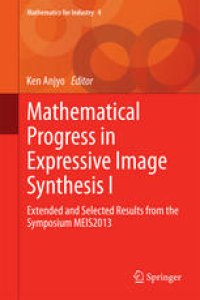
Ebook: Mathematical Progress in Expressive Image Synthesis I: Extended and Selected Results from the Symposium MEIS2013
Author: Ken Anjyo (eds.)
- Tags: Signal Image and Speech Processing, Computer Graphics, Mathematical Applications in Computer Science, Appl.Mathematics/Computational Methods of Engineering
- Series: Mathematics for Industry 4
- Year: 2014
- Publisher: Springer Japan
- Edition: 1
- Language: English
- pdf
This book presents revised versions of the best papers selected from the symposium “Mathematical Progress in Expressive Image Synthesis” (MEIS2013) held in Fukuoka, Japan, in 2013. The topics cover various areas of computer graphics (CG), such as surface deformation/editing, character animation, visual simulation of fluids, texture and sound synthesis and photorealistic rendering. From a mathematical point of view, the book also presents papers addressing discrete differential geometry, Lie theory, computational fluid dynamics, function interpolation and learning theory. This book showcases the latest joint efforts between mathematicians, CG researchers and practitioners exploring important issues in graphics and visual perception.
The book provides a valuable resource for all computer graphics researchers seeking open problem areas, especially those now entering the field who have not yet selected a research direction.This book presents revised versions of the best papers selected from the symposium “Mathematical Progress in Expressive Image Synthesis” (MEIS2013) held in Fukuoka, Japan, in 2013. The topics cover various areas of computer graphics (CG), such as surface deformation/editing, character animation, visual simulation of fluids, texture and sound synthesis, and photorealistic rendering. From a mathematical point of view, the book also presents papers addressing discrete differential geometry, Lie theory, computational fluid dynamics, function interpolation, and learning theory. This book showcases the latest joint efforts between mathematicians, CG researchers, and practitioners exploring important issues in graphics and visual perception.
The book provides a valuable resource for all computer graphics researchers seeking open problem areas, especially those now entering the field who have not yet selected a research direction.